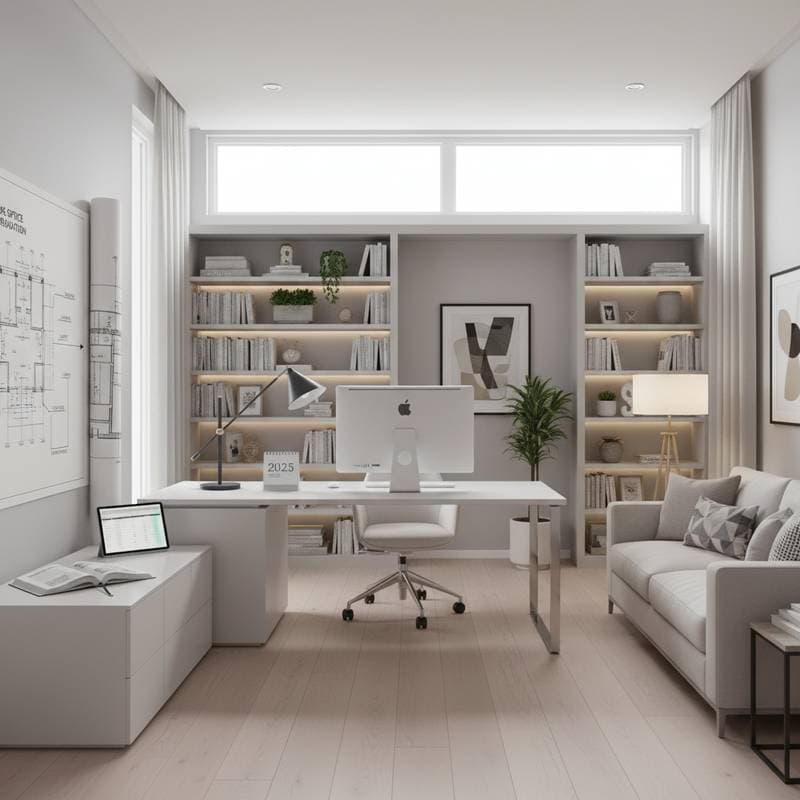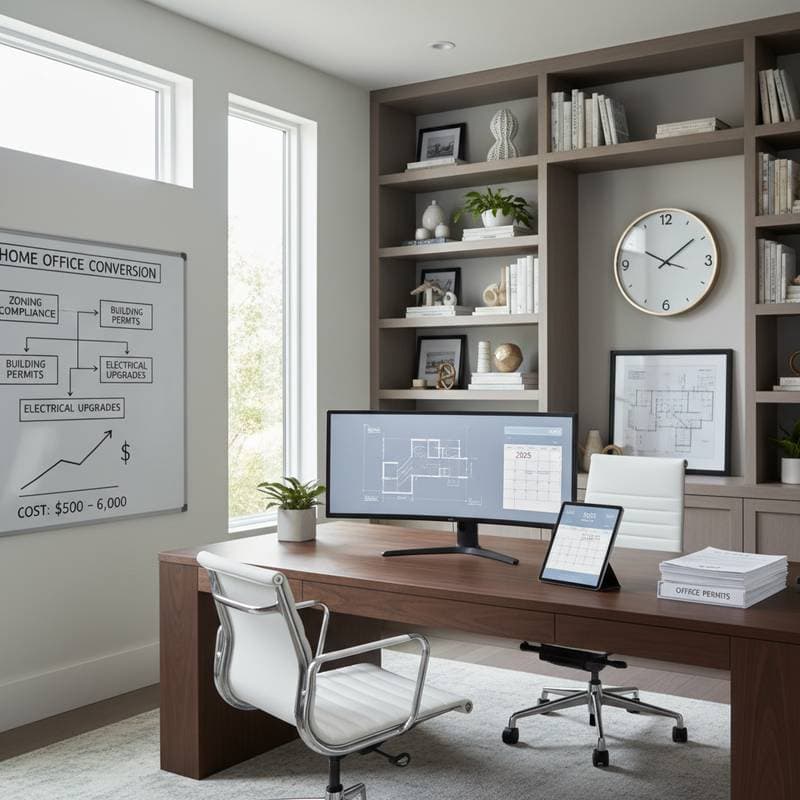Unlock Living Space: 2025 Garage Conversion Costs
Quick Take
A garage conversion adds real living space without expanding your home’s footprint.
- Expect total costs between $25,000 and $90,000, depending on finish and layout.
- One can save by managing minor work oneself, but structural and code items require a professional.
- Plan early for permits, insulation, and heating or cooling needs.
Pros and Cons
Pros
- Adds livable square footage without a full addition.
- Can raise property value when done to code.
- Uses existing structure, which shortens build time.
- Ideal for multigenerational housing or rental income.
Cons
- Permanent loss of covered parking or storage.
- Requires full insulation and HVAC upgrades.
- May trigger zoning or setback restrictions.
- Can expose hidden issues like cracked slabs or poor drainage.
Step-by-Step
Tools and Materials:
Tape measure, framing hammer, circular saw, drill set, insulation batts, vapor barrier, drywall panels, joint compound, interior paint, flooring materials, HVAC unit or mini split, and safety gear (gloves, mask, eye protection).
Time and Difficulty:
Six to twelve weeks for full conversion. Moderate to advanced difficulty depending on finish level.
-
Inspect the Structure
Examine the foundation for cracks, signs of moisture, or pest damage. Verify that the concrete slab remains level and dry. Assess the roof for sagging and the framing for any damage. -
Plan the Layout
Determine the intended use of the space. A studio layout requires plumbing for a bathroom and kitchenette. An office or gym typically needs only additional outlets and climate control. Sketch placements for doors and windows to satisfy natural light requirements in local codes. -
Get Permits
Submit detailed drawings that include electrical, plumbing, and HVAC specifications. Most jurisdictions mandate inspections for egress windows, minimum ceiling height, and appropriate insulation R-values. -
Frame and Insulate
Install wall studs if the garage lacks interior framing. Apply a moisture barrier followed by insulation suitable for the local climate. Place rigid foam boards directly on the concrete slab before laying subfloor panels. -
Rough-In Systems
Route electrical wiring to support outlets and lighting fixtures. Incorporate plumbing lines if a bathroom or kitchenette forms part of the design. Install ductwork or lines for a mini-split system prior to enclosing with drywall. -
Install Drywall and Finish Surfaces
Secure drywall sheets to the framing, tape and mud the seams, then sand for a smooth finish. Apply primer followed by two coats of paint. Select and install flooring such as vinyl plank, laminate, or carpet. -
Add Fixtures and Trim
Mount lighting fixtures, hang doors, and attach baseboards. Paint the trim and perform final touch-ups on the walls. -
Inspect and Approve
Arrange for the final inspection to confirm compliance with all codes. Retain copies of permit documents for future home resale. -
Furnish and Move In
After approval, introduce furniture and evaluate overall comfort. Make adjustments to window treatments or ventilation as necessary to achieve optimal airflow.
DIY vs Pro
Safe for DIY if:
- One possesses skills in light framing, painting, and flooring installation.
- Basic electrical safety principles are understood, and conduit work occurs under professional supervision.
- All specifications for insulation and vapor barriers receive strict adherence.
Hire a Pro When:
- Plumbing or HVAC systems require installation.
- Modifications involve load-bearing walls or the garage door structure.
- Stamped structural plans become necessary for permit approval.
What the Pro Does Differently:
A licensed contractor handles permit applications, schedules inspections, and coordinates with specialized trades. Professionals possess in-depth knowledge of local codes, which minimizes the risk of failed inspections. They also provide guidance on essential elements such as moisture barriers, subfloor elevation, and soundproofing techniques.
Alternatives
Option A: Detached ADU Conversion
This approach suits rental income generation or enhanced privacy. It creates a complete secondary dwelling unit with its own entrance. However, expect elevated costs and more rigorous permitting processes.
Option B: Garage Loft Addition
This method preserves parking space below while adding a second story above the garage. It maintains the garage's original function but introduces higher expenses and greater structural demands.
Option C: Partial Conversion
Ideal for versatile usage, this converts only half the garage into an office or gym while retaining space for one vehicle. The reduced scope lowers costs and simplifies zoning compliance.
FAQs
Can I convert without changing the exterior?
Yes, one can retain the garage door's outward appearance. Frame an interior wall behind it and add matching siding or windows to maintain curb appeal.
Do I need new foundation work?
Typically, no, unless the slab shows significant cracks or excessive slope. Apply self-leveling compound to address minor uneven areas.
Will it raise my property taxes?
Likely, as finished living space increases the assessed value. Consult the local tax assessor prior to commencing the project.
Can I rent it out right away?
Only if zoning regulations permit accessory dwelling units or rental spaces. Verify requirements with the local planning department.
How good should insulation be?
Align it with the main home's walls. Install R-13 to R-21 in walls and R-30 or higher in ceilings to ensure comfort and meet code standards.
Can I keep the garage door for looks?
Yes, but insulate and seal it from the interior side. Some opt to replace it with a fixed wall and decorative panels for superior airtightness.
Do I need new HVAC?
If the primary system has sufficient capacity, extend the ductwork. Otherwise, install a ductless mini-split for efficient heating and cooling.
What if my garage floods during heavy rain?
Address drainage issues before conversion. Install perimeter drains or elevate the flooring to prevent mold and structural damage.
Checklist
- Inspect structure for cracks, moisture, and pests.
- Measure ceiling height and window area for code compliance.
- Plan layout and plumbing routes.
- Apply for permits before starting work.
- Insulate walls, ceiling, and slab.
- Install HVAC suited for space size.
- Finish drywall and flooring.
- Schedule final inspection.
- Maintain HVAC filters and moisture control.
Making It Happen
Approach the garage conversion as a project that balances design innovation with regulatory compliance. Define the space's purpose from the outset. A rental suite demands plumbing and measures for privacy, while a playroom or office prioritizes comfort and natural illumination. Construct the budget around this intended function rather than square footage alone.
Engage with the local building department at the planning stage. Inquire about parking mandates, insulation standards, and definitions of accessory dwelling units. These factors influence the layout and overall expenses more profoundly than surface finishes.
For constrained budgets, consider phasing the construction. Complete framing, insulation, and drywall installation initially. Incorporate plumbing or custom built-ins in subsequent stages. This strategy delivers functional space promptly while distributing financial commitments over time.
Upon completion, the converted garage integrates seamlessly into everyday life. It may function as guest quarters, a home office, or a revenue-generating unit. Sustain dryness, proper ventilation, and code adherence to safeguard the investment and ensure long-term comfort.



